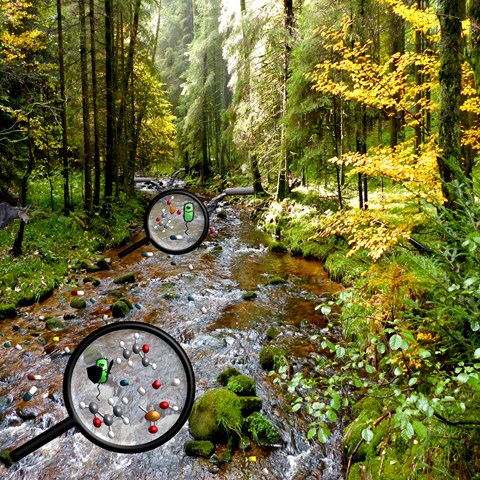Contact
Department of Aquatic Sciences and Assessment, Division of Environmental Organic Chemistry and Ecotoxicology
Department of Aquatic Sciences and Assessment, Division of Environmental Organic Chemistry and Ecotoxicology

The increased presence of antimicrobial substances in water is a concern. The substances can be transformed over their life cycle through several different processes. SLU researchers have therefore compiled an overview of transformation products and estimated their risks.
The aquatic environment is an important reservoir of antibiotic resistance. It is therefore crucial to understand what happens to the antimicrobial substances in there, especially with the increasing use of antibiotics.
- Several studies have focused on what happens to antibacterials in humans and animals, but so far there has not been much research about how they affect the environment. There has been even less research about the substances that are converted into another chemical form, so-called transformation products, says Paul Löffler, PhD student at the Department of Aquatic Sciences and Assessment, and head author of the compilation.
Especially when it comes to antibiotic resistance, it is important to take a broad perspective that includes all parts that are affected by antibiotics. Humans, animals, and nature are all involved in the development of resistance to antibacterial agents.
SLU researchers have therefore conducted a thorough analysis of all reported antibacterial transformation products that have occurred in surface water environments worldwide. Therefore, the work presented by the researchers in a scientific paper also includes the main factors behind the processes that alter the antibacterial substances.
Paying attention to the transformation products gives a better overall picture of the situation in the environment. A water sample provides a snapshot, but when you understand what has happened and can happen to the substances in the sample, your understanding becomes more complete.
To make the assessment more straightforward of which transformed antibacterial substances should be paid attention to and removed from the water, the SLU researchers drew up a list based on associated hazards and risks, such as the ability to induce antibiotic resistance.
- We assume that when the TPs are more than 95% structurally similar to the original (parent) antibiotic, they tend to share very similar biological activity, says Paul.
The researchers have also categorised and ranked the substances on the list to facilitate the mitigation of those substances of greatest risk. The list, therefore, offers an important contribution to the fight against antimicrobial resistance.
- We hope that the list will be used by researchers in several different fields to work towards understanding these substances and reduce the development and spread of antimicrobial resistance, says Paul. The list highlights which substances are important to focus on. We ourselves will use the list to further explore and elaborate the risks from the different transformation products.
An antibacterial substance in water can change through several different processes, such as biological degradation and UV light. The substance then becomes different from the original substance, a relationship that researchers liken to a parent-child relationship. The child substance is considered a transformation product (TP).
- We track certain antibacterial substances and their presence in aquatic environments, says Paul. But because environmental processes change the substances and turn them into new transformed products, there is a high risk of losing track and overlooking substances.
Therefore, understanding what happens to different substances is central to the fight against undesired effects such as environmental consequences or antibiotic resistance, and this requires knowledge. Transformation products often have a similar molecular structure to their parent chemical and could therefore exhibit similar behavior and cause similar effects in the environment and in humans and animals. They can pose a similar risk to their surrounding environment, but also an even greater risk.
The development of resistance is completely natural and normal. It is a fight against time as antibiotics will sooner or later lose their power due to the adaptive nature of bacteria. Therefore, it is important to find new antibiotics. The lack of innovation of new antibiotics has led to the development of resistance in bacteria, which was favored by years of excess and improper use. This is a problem for humans, animals, and the environment. It is important that work on antibiotic resistance is done with the three perspectives in mind as they are interrelated and influence each other.
Despite campaigns, the use of antibiotics has increased globally in recent years and is therefore increasingly important to investigate. But it requires continued research and collaboration between research institutions, governments, and international organisations to protect the environment and global One Health.